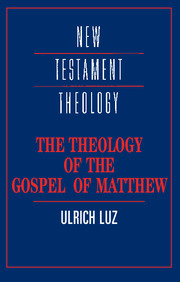Book contents
- Frontmatter
- Contents
- Editor's preface
- Author's preface
- List of abbreviations
- 1 The Book
- 2 The Prologue (Matthew 1:1 – 4:22)
- 3 The discourse on the Mount (Matthew 5 – 7)
- 4 The ministry of the Messiah and his disciples in Israel (Matthew 8:1 – 11:30)
- 5 The origins of the community of disciples in Israel (Matthew 12:1 – 16:20)
- 6 The life of the community of disciples (Matthew 16:21 – 20:34)
- 7 The final reckoning with Israel and the judgement of the community (Matthew 21:1–25:46)
- 8 Passion and Easter (Matthew 26 – 28)
- 9 Concluding thoughts
- Further reading
- Subject index
- Index of citations from Matthew
7 - The final reckoning with Israel and the judgement of the community (Matthew 21:1–25:46)
Published online by Cambridge University Press: 05 June 2012
- Frontmatter
- Contents
- Editor's preface
- Author's preface
- List of abbreviations
- 1 The Book
- 2 The Prologue (Matthew 1:1 – 4:22)
- 3 The discourse on the Mount (Matthew 5 – 7)
- 4 The ministry of the Messiah and his disciples in Israel (Matthew 8:1 – 11:30)
- 5 The origins of the community of disciples in Israel (Matthew 12:1 – 16:20)
- 6 The life of the community of disciples (Matthew 16:21 – 20:34)
- 7 The final reckoning with Israel and the judgement of the community (Matthew 21:1–25:46)
- 8 Passion and Easter (Matthew 26 – 28)
- 9 Concluding thoughts
- Further reading
- Subject index
- Index of citations from Matthew
Summary
JESUS IN JERUSALEM
With the entrance of Jesus into Jerusalem a new stage opens up in our story. Jerusalem is the city of Jesus' adversaries, the Jewish leaders (2:3–4; 15:1). It is the city in which Jesus is foreordained to die (16:21; 20:17–18). The readers know that the moment of decision is drawing near. The tension increases accordingly.
Jesus' deeds in Jerusalem cover three sequences of narrative and a discourse. The first narrative sequence makes up the exposition (21:1–27). Here Matthew relates two days of Jesus' stay in Jerusalem. First he recounts Jesus' entry into the city (21:1–11) and, from there, his appearance in the Temple (21:12–17). The focus falls on his encounter with the people. Outside the city the people prepare a triumphal reception, welcoming him as the Son of David and the Messiah (21:9; see 12:23). Entering the Temple, Jesus enacts a prophetic sign by driving out the merchants, for the house of God is to be a house of prayer. No longer does Matthew refer to a ‘house of prayer for all the nations’ (Mark 11:17). He knows that the time of the Temple is past, even for the nations. Most of all, however, Jesus heals the sick among the people one final time (21:14). In the Temple itself he is the healing Messiah of the poor and simple. Up to this point everything is exactly as it was: Jesus still stands in the people's favour, and they are still not far from the truth.
- Type
- Chapter
- Information
- The Theology of the Gospel of Matthew , pp. 117 - 132Publisher: Cambridge University PressPrint publication year: 1995

